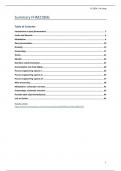Samenvatting
Summary Food Fermentation (FHM21806)
- Instelling
- Wageningen University (WUR)
This summary was written in this academic year. It contains all lecture notes from this course, combined with the provided literature, quiz answers (incorporated in the text) and information from the preceding course Food Microbiology (FHM20306). Topics covered in the summary: - Notes from all ...
[Meer zien]




